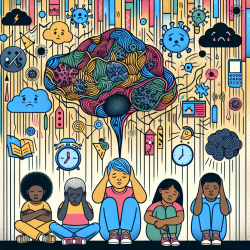Introduction
As practitioners dedicated to improving the outcomes for children, it's crucial to integrate evidence-based strategies into our practices. A recent systematic review published in the International Journal of Behavioral Nutrition and Physical Activity provides valuable insights into how combinations of physical activity, sedentary time, and sleep duration can influence depressive symptoms and other mental health indicators in children and adolescents. By understanding and applying these findings, we can better support the mental well-being of the young individuals we serve.
The Research Findings
The systematic review analyzed data from 13 cross-sectional studies involving 115,540 children and adolescents across 12 countries. The findings revealed that meeting all three recommendations of the Canadian 24-Hour Movement Guidelines—sufficient physical activity, limited screen time, and adequate sleep—was associated with better mental health indicators compared to meeting none of the recommendations. Notably, the combination of meeting screen time and sleep duration recommendations appeared to offer more mental health benefits than meeting the physical activity recommendation alone.
Implications for Practice
For practitioners, these findings underscore the importance of promoting balanced movement behaviors in children and adolescents. Here are some actionable steps to consider:
- Encourage Physical Activity: Aim for at least 60 minutes of moderate-to-vigorous physical activity daily. This can be through structured sports, active play, or family activities.
- Limit Screen Time: Advocate for no more than 2 hours of recreational screen time per day. Encourage engaging in non-screen activities like reading or outdoor play.
- Promote Healthy Sleep Habits: Ensure children get 9-11 hours of sleep (ages 5-13) or 8-10 hours (ages 14-17) per night. Establish a consistent bedtime routine and create a sleep-conducive environment.
Encouraging Further Research
While the current evidence is compelling, the quality of evidence was rated as "very low" due to reliance on cross-sectional studies and self-reported measures. Therefore, there is a need for more high-quality research to explore these associations further. Practitioners can contribute by supporting studies that use longitudinal and experimental designs, robust measures of movement behaviors, and validated mental health assessments.
Conclusion
Integrating the findings from this systematic review into practice can significantly enhance the mental health outcomes of children and adolescents. By promoting a balanced approach to physical activity, screen time, and sleep, practitioners can help mitigate depressive symptoms and improve overall mental well-being. Let's work together to ensure that the children we serve have the best possible foundation for a healthy future.
To read the original research paper, please follow this link: Combinations of physical activity, sedentary time, and sleep duration and their associations with depressive symptoms and other mental health problems in children and adolescents: a systematic review.










